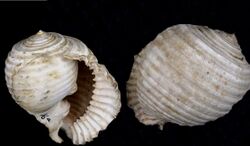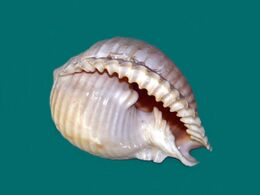Biology:Malea ringens
| Grinning tun | |
|---|---|

| |
| Two views of a shell of Malea ringens (museum specimens at Naturalis Biodiversity Center) | |
| Scientific classification | |
| Domain: | Eukaryota |
| Kingdom: | Animalia |
| Phylum: | Mollusca |
| Class: | Gastropoda |
| Subclass: | Caenogastropoda |
| Order: | Littorinimorpha |
| Family: | Tonnidae |
| Genus: | Malea |
| Species: | M. ringens
|
| Binomial name | |
| Malea ringens (Swainson, 1822)[1]
| |
| Synonyms[2] | |
|
synonymy
| |
Malea ringens, common name the grinning tun, is a species of large sea snail, a marine gastropod mollusk in the family Tonnidae, the tun shells.[2]
Distribution
This species occurs in the Pacific Ocean from Mexico to Peru and off Galapagos Islands.[3]
Description
The size of the shell of Malea ringens varies between 60 mm and 270 mm, with an average diameter of about 100 mm.[3] It is one of the largest of Panamic shells. These shells are basically white and delicately spotted with yellow under the thin periostracum.[4]
The pretty thick shell is ovate-globose and ventricose. The pointed spire is formed of six whorls, the upper of which are slightly convex, but little developed, having three or four transverse striae, very apparent, and spotted with brown blotches. The body whorl is very much inflated, completely surrounded by from fifteen to twenty equal ribs, depressed, but slightly rounded. These ribs are separated from each other by a shallow furrow, which becomes wider between the first two or three upper ribs, by the disappearance of the intermediate ribs. The longitudinal striae of growth are numerous, very fine, and slightly apparent.
The aperture is narrow, for it is much contracted by two protuberances situated upon the two lower thirds of the columella. The outer lip is arched, flattened, widened within, having a wide longitudinal ridge outside of it. It has, on the inside, the whole length, from sixteen to eighteen ridges, or very strongly prominent teeth. The edge is undulated and denticulated. The inner lip is thin, diaphanous, spreading upon the body of the shell, to which it adheres, except towards the base, where it becomes free and thicker. The columella is twisted, and presents a very deep emargination, above which is seen a wide, thick, furrowed tubercle, which appears as if suspended over this hollow. Another tubercle projects near the base, separated from the first by the cavity just spoken of. It is furnished with wrinkles and numerous furrows of a brilliant white, which imperceptibly diminish in size at the base, and above the emargination, which is turned out like a gutter, and perfectly smooth. The color of this shell is whitish, slightly blended with a dull yellow. The interior is red. The periostracum is thin and yellowish.[5]
References
- ↑ Swainson. 1822. Cat. Bligh, Append: 4, pl.5, fig.27.. World Register of Marine Species, Retrieved 9 July 2010.
- ↑ 2.0 2.1 Malea ringens (Swainson, 1822). Vos, C. (2009). Malea ringens (Swainson, 1822). Accessed through the World Register of Marine Species at http://www.marinespecies.org/aphia.php?p=taxdetails&id=410241 on 9 July 2010 .
- ↑ 3.0 3.1 "Malea ringens - Hardy's Internet Guide to Marine Gastropods". gastropods.com. http://www.gastropods.com/1/Shell_1001.shtml. Retrieved 2016-11-05.
- ↑ Angeline Myra Keen Sea Shells of Tropical West America: Marine Mollusks from Baja California to Peru
- ↑ Kiener (1840). General species and iconography of recent shells : comprising the Massena Museum, the collection of Lamarck, the collection of the Museum of Natural History, and the recent discoveries of travellers; Boston: W.D. Ticknor, 1837 (described as Dolium latilabre)
- Swainson, W. (1822) Appendix: Description of several new shells, and remarks on others, contained in the collection of the late Mrs. Bligh. In: A catalogue of the rare and valuable shells, which formed the celebrated collection of the late Mrs. Bligh. The sale of this collection ... 20 May 1822. C. Dubois, London: appendix, pp. 1–20 page(s): 4
External links
- "Malea ringens" (in en). Gastropods.com. http://www.gastropods.com/1/Shell_1001.shtml.
Wikidata ☰ Q6775263 entry
 |


